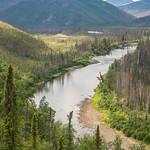The BLM invites public comment on a new river management plan for the Birch Creek Wild and Scenic River
Organization:
BLM Office:
Media Contact:
FAIRBANKS, Alaska — The Bureau of Land Management welcomes public comment to aid in resource management planning for the Birch Creek Wild and Scenic River that flows through BLM-managed public lands in central Alaska. The virtual public meeting will be held Jan. 17 from 5 to 7 p.m. via Zoom. The BLM will share information about the planning process during the meeting and allow an opportunity for the public to ask questions and provide comments related to the management of the wild and scenic river.
“Wild and scenic rivers help protect water quality, maintain biodiversity and increase landscape resilience for the benefit and enjoyment of present and future generations,” said BLM Fairbanks District Manager Geoff Beyersdorf. “Gathering public input helps us to prepare plans that are responsive to public values and interests.”
The BLM is developing a new comprehensive river management plan to update the 1983 River Management Plan for the Birch Creek Wild and Scenic River. The new plan will align with the Biden-Harris Administration’s 30x30 and America the Beautiful goals to conserve America’s lands and waters for the benefit of all people.
The purpose of the new plan is to identify methods to protect and enhance the values that caused the river to be included in the National Wild and Scenic River System. Specifically, the plan will manage for “wild” characteristics, free-flowing waters, water quality, and outstandingly remarkable values, including recreational uses, fisheries, and scenic values. Of the 126-mile Birch Creek Wild and Scenic River, approximately 77 miles flow through the BLM-managed Steese National Conservation Area, before flowing into the broad expanse of the Yukon Flats in central Alaska.
The new plan will address resource protection, development of lands and facilities, user capacities and other management practices necessary or desirable to achieve the purposes of the Wild and Scenic Rivers Act of 1968. Public input helps to determine what parameters to consider. Learn more about planning and provide input on the BLM National NEPA Register project website or by attending the virtual public meeting.
Interested members of the public may attend all or portions of the virtual meeting and provide input during the question-and-answer session. To attend the virtual meeting, please register at this link: [Expired Zoom link removed]
BLM welcomes input anytime during the planning process. To begin planning, we are requesting the public to comment by Feb. 4. However, information received after this date may still be considered.
Provide comments on management of Birch Creek Wild and Scenic River:
-
By mail or hand delivery to Attention: Birch Creek, BLM Eastern Interior Field Office, 222 University Avenue, Fairbanks, Alaska 99709
-
By email to [email protected]
-
Get involved on the BLM’s National NEPA Register project page
For more information about the virtual meeting, or planning for the Birch Creek Wild and Scenic River, please contact Collin Cogley at the Eastern Interior Field Office at 907-474-2200.
-BLM-
Bureau Of Land Management, Fairbanks District Office, 222 University Avenue, Fairbanks, AK 99709
Need public domain imagery to complement news coverage of the BLM in Alaska? Visit our Flickr channel!
Learn more at www.blm.gov/Alaska, and on Facebook, Instagram, Twitter, and YouTube.
The BLM manages about 245 million acres of public land located primarily in 12 western states, including Alaska, on behalf of the American people. The BLM also administers 700 million acres of sub-surface mineral estate throughout the nation. Our mission is to sustain the health, diversity, and productivity of America’s public lands for the use and enjoyment of present and future generations.

